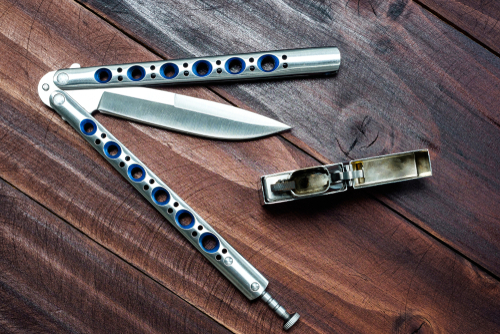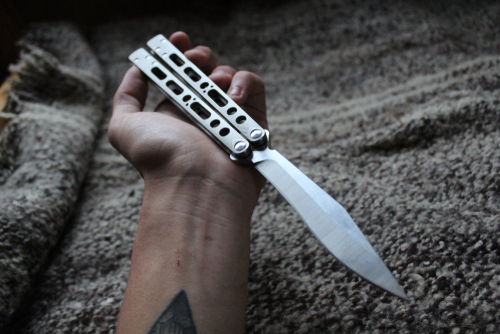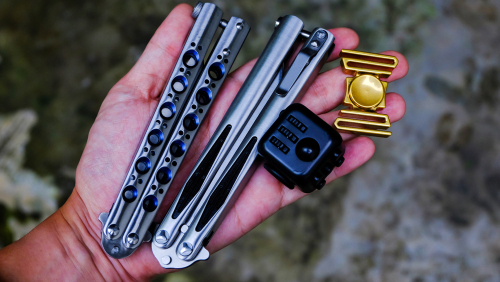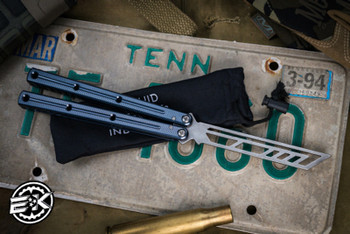Balisong Beginners: 4 Easy Tricks to Do with a Custom Butterfly Knife
Jul 3rd 2018

Balisong, or butterfly knives, are some of the most versatile tools you can have in an emergency survival or self-defense situation. The utility, concealability and, let’s face it, downright stylish appearance of balisong knives make them a popular go-to carry choice among knife enthusiasts around the world.
But when it comes down to it, a weapon is only as useful as its carrier. These tips and tricks for learning how to handle and care for your custom butterfly knife are the first steps you can take to becoming an expert balisong knife handler. And if you don’t own a butterfly knife just yet, you can find the right one for you by checking where there is a butterfly knife for sale, saving you time and money.
1. Flip Opening
The standard flip opening is likely the very first trick your favorite high-profile balisong knife work professionals learned, and it’s an excellent place to start. A successful flip opening will open the blade by rotating it 360 degrees to the open position in one, smooth motion.
Find the Right Butterfly Knife for Sale to Fit Your Needs
The trick behind the flip opening is learning how to manipulate the flip mechanism of your knife with the movement of your wrist and not your fingers while keeping control of the safety handle. Mastering the flip opening gives beginners a better feel for the mechanics of their knife and how it works in their hands.
2. Pinwheel
The pinwheel is a balisong classic. It’s the trick any butterfly knife-wielder is going to be performing on the big screen and a real crowd pleaser at knife shows.
Though there are many variations of the pinwheel opening, each creates the iconic pinwheel effect to open the blade. In the starting position, the knife is held horizontally with the tang pins pointed in alignment with your thumb. You then hold the safe handle and drop the bite handle, flipping it around while shifting your grip so the bite handle is now held upward and snapped into its closed position.
The pinwheel is a more advanced skill that requires substantial practice to master. However, once you have achieved the basic motion, it can easily be applied to pinwheel variations that are an impressive addition to your repertoire.
3. Basic Aerial

Like the pinwheel, aerial tricks with your custom balisong are versatile, and there are many variations you can perform and make your own once you’ve mastered the basic aerial.
Microtech Knives Are Durable and Reliable
If you have mastered the other tricks on this list, then you understand the mechanics of your knife and the exact amount of effort it takes to complete a full rotation. A basic aerial consists of exactly that: One full blade rotation in mid-air. After the blade has rotated past your hand, you grab the handles of the blade in the open position.
4. Flip Closing
Flip closing is simply the reverse of the opening you’ve already mastered. Rather than flicking your wrist to manipulate the blade into its open position, you’ll complete the opposite motion to send it back to the concealing handle.
One trick to successfully flip closing your blade is to ensure you keep your palms open to give the blade enough room to swing back into its concealed position without slicing your hands.
Safety Tips
Of course, sustaining the occasional cut is just a part of balisong training, but it is best to avoid cuts where possible and always remain alert throughout your practice to mitigate accidents. After all, the art of successfully manipulating your custom butterfly knife is about doing so without an injury.
Custom knives are great because they can be designed to your exact preference. Plus, they can be engraved with a personal design to really vamp up its appearance.
To begin training with your custom balisong, consider taping the edge of the blade with heavy electrical tape to render the blade harmless. This eliminates the risk of injury and helps you overcome your initial fear of being cut which allows you to become more comfortable with your blade.
Or consider purchasing a training balisong, a butterfly knife with all the components except the sharpened blade.
Maintenance

One of the most underutilized tips for balisong beginners is proper balisong maintenance. You’ll never achieve the butter-smooth action you are looking for with a neglected knife.
Don’t just close your custom balisong and put it away after an intensive practice session. Inspect it carefully for loose screws and pivots. After this, give your knife a once-over with a knife cleanser or soap and water to remove any dirt and grime that can affect the integrity of the blade over time. It’s important you know how to clean a pocket knife so it doesn’t rust or damage.
After washing, dry your blade thoroughly. Finally, apply a lubricant to all the pivot points to keep the joints moving freely just like you need them to.
The Final Word
Once you’ve mastered these basic tricks and become more familiar with how your blade works in your hands, moving to advanced knife work is more natural, enjoyable and, hopefully, cut-free.
Remember, caring for your blade is half the battle. Practice and proper maintenance will ensure your custom balisong knife works how you need it to when you need it to and that you are never caught off guard with rusty skills and a rusty blade.

